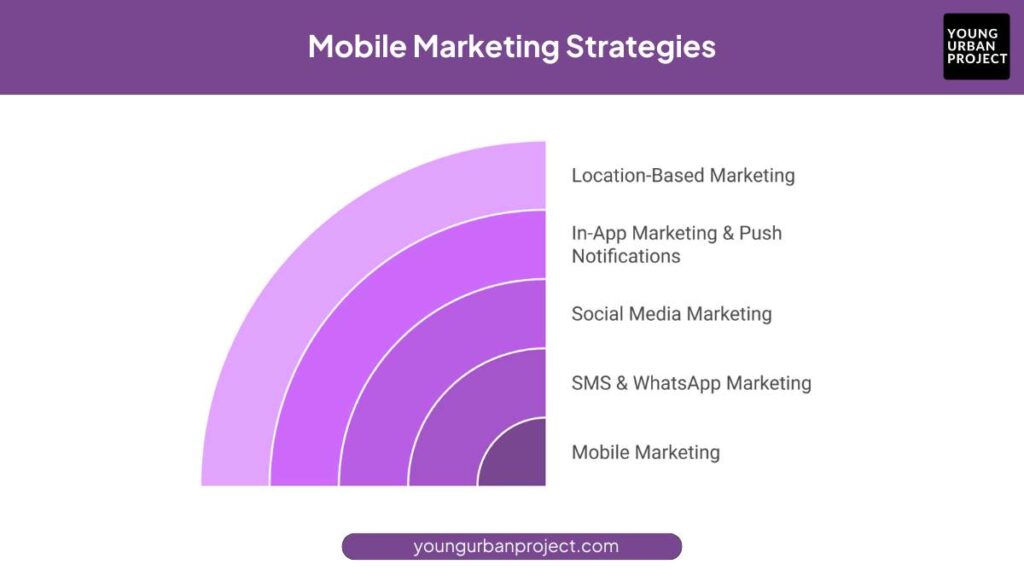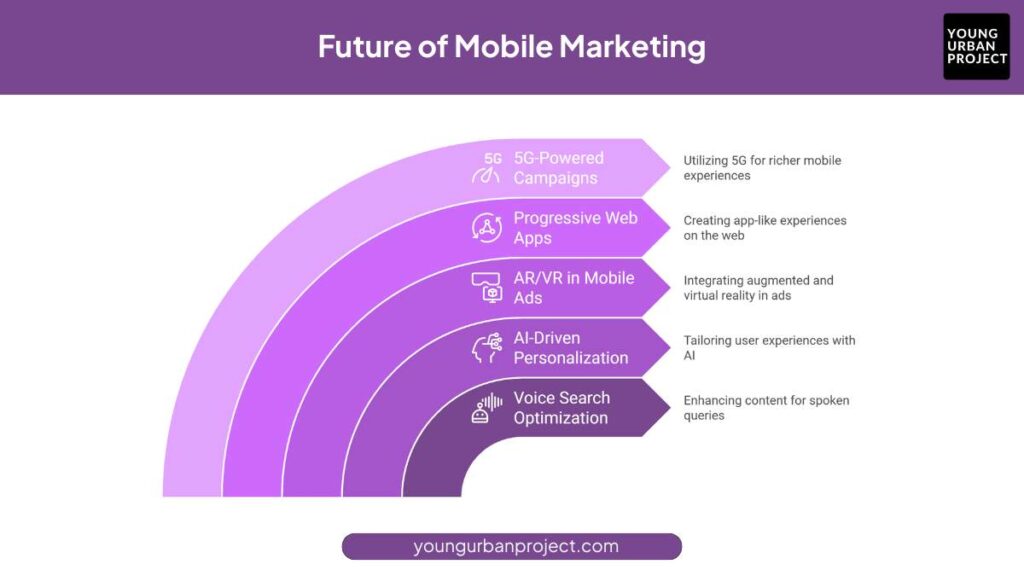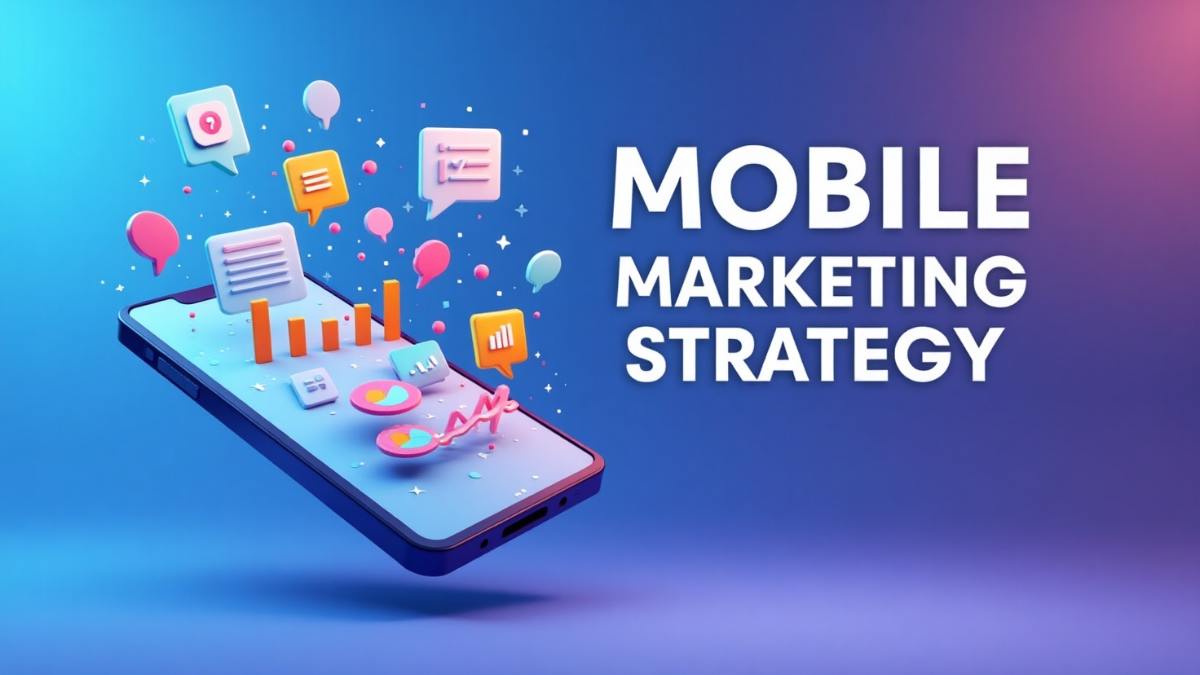Let’s be honest, we’re all glued to our phones. Whether we’re doom-scrolling on Instagram, ordering food, or even checking emails between meetings, mobile is where attention lives.
And brands know it too. In 2025, mobile isn’t just one part of marketing anymore, it’s the center of it.
Consider this: global mobile users have already crossed 7.5 billion. Over 63% of web traffic now comes from mobile devices. And people don’t just browse, they buy, they book, they engage.
So, if you’re not thinking mobile-first with your marketing strategy yet… you’re basically leaving money on the table.
Let’s break it all down so you can build a killer mobile marketing strategy this year.
Table of Contents
What is Mobile Marketing?
Let’s not overcomplicate this, mobile marketing is basically any marketing activity that’s designed specifically for smartphones, tablets, or other mobile devices.
It’s about reaching people where they already are.
But here’s the key: it’s not just about where you reach them, it’s about how. Mobile marketing uses things like:
- Mobile apps (e.g., brand apps, loyalty apps)
- SMS & WhatsApp messages
- Push notifications
- Mobile-optimized websites
- Location-based offers
- Social media (because, hello… almost all of it happens on mobile now)
The goal? Create frictionless, personal, and timely experiences for users who expect everything to work perfectly on that small screen.
Core Elements of a Winning Mobile Marketing Strategy
Before we get into specific tactics, you’ve got to build the foundation right. Think of this as your mobile marketing toolkit before you go building skyscrapers.
1. Clear Objectives & Audience Personas
If you don’t know why you’re doing mobile marketing or who you’re speaking to, nothing else matters. Start with solid goals like:
- Increasing app downloads
- Boosting purchase frequency
- Getting more repeat visits
- Improving customer loyalty
Then map out clear personas:
- What do your ideal customers care about?
- When are they usually active on their phones?
- What type of content excites them?
2. Mobile-Optimized Content & UX
There’s nothing worse than clicking an ad and landing on a clunky, desktop-style website on your phone. People bounce instantly if the experience feels slow or annoying.
- Fast-loading pages
- Easy-to-tap buttons
- Readable text
- Short, punchy content
- Thumb-friendly design
Basically, respect the scroll.
3. Channel Selection
Not every mobile channel makes sense for every business. Choose wisely:
- B2C brands? SMS, WhatsApp, Instagram, TikTok.
- SaaS or B2B? Maybe focus more on mobile email, LinkedIn, or apps.
- Local stores or restaurants? Definitely location-based and push notifications.
4. KPIs & Analytics
If you don’t measure it, you can’t improve it. Track KPIs like:
- Click-through rates (CTR)
- App engagement metrics
- Conversion rates by device
- Location-based campaign performance
- Cost per install (if running app campaigns)
Top Mobile Marketing Strategies to Use in 2025
Now for the juicy part: the actual strategies you should be focusing on this year.

1. SMS & WhatsApp Marketing
SMS might sound old school, but that’s exactly why it works. Hardly anyone ignores a text notification.
WhatsApp, on the other hand, is becoming the go-to for conversational marketing in places like India, Brazil, and Europe.
Pro tip: Use it sparingly and always offer value. Flash sales, appointment reminders, or loyalty rewards work brilliantly here.
Example:
Zomato sending personalized food deals around lunchtime based on previous orders, ridiculously effective.
2. Social Media Marketing on Mobile
Almost every popular social platform today is built for mobile first. Instagram, TikTok, Snapchat, YouTube Shorts, they all dominate attention spans on the phone.
If you’re not creating vertical videos or stories optimized for one-handed scrolling, you’re probably invisible.
Brands killing it here?
- Duolingo, playful TikToks with that slightly unhinged green owl.
- Sephora, interactive Instagram Reels showing off product demos.
3. In-App Marketing & Push Notifications
You’ve probably seen these:
- “Hey! You left something in your cart 🛒”
- “Check out what’s new this week”
These little nudges bring people back to your app and help keep them engaged.
But remember, overdo it, and you’ll get muted or uninstalled. Balance is everything.
Tool to help? Airship, great for managing push notifications and in-app messaging journeys.
4. Location-Based & Proximity Marketing
Ever walked past a café and suddenly got a notification offering you a discount on coffee? That’s proximity marketing at work.
In 2025, this is powered by:
- GPS
- Bluetooth beacons
- Geofencing
Great for retailers, restaurants, events, or even transportation apps. Just… keep it relevant. Nobody wants spam based on their location.
Example:
Starbucks, they’ve mastered geo-targeted promotions for nearby stores.
5. Mobile Email Marketing
Yes, email is still here, but you must design for mobile-first now.
- Single-column layouts
- Large, clickable CTAs
- Avoid giant images that slow down loading
- Short subject lines = higher opens
Bonus tip: Use dark mode–friendly designs. Tons of users prefer it now, and unreadable emails are just embarrassing.
Also Read: Email Newsletter Format
Emerging & Advanced Mobile Marketing Strategies
Alright, we’ve talked about the usual suspects, but let’s level up. Mobile marketing in 2025 isn’t just about texts and push notifications anymore.

Let’s look at some next-level tactics that’ll help you stand out from the crowd:
1. Voice Search Optimization for Mobile
Think about it, when was the last time you asked Google or Siri to find something for you? Happens more than we realize.
“Hey Siri, where’s the best pizza near me?”
“Ok Google, cheapest flights to Goa.”
People don’t just type anymore, they talk to their phones. That’s exactly why Voice Search Optimization is becoming such a big deal, especially for local businesses.
- Conversational keywords (long-tail, question-based)
- Local listings (Google My Business is your friend)
- Quick, scannable answers
If your business serves local areas or offers services people search for on the go, this is a no-brainer.
2. AI-Driven Personalization
AI is getting scary good, in a good way.
Imagine someone opens your app, and instead of showing the same homepage to everyone, it rearranges products based on what they’ve liked before. That’s AI doing personalization behind the scenes.
Example: Netflix’s recommendations? Amazon’s “you might also like”? Yeah, same game.
Tools like MoEngage or Leanplum help brands do this across mobile push, emails, and in-app screens.
Bottom line: treat your users like individuals, not numbers.
3. AR/VR in Mobile Ads
Remember those fun Snapchat or Instagram filters where you can try on sunglasses or lipstick? That’s AR (Augmented Reality) in action.
Now imagine seeing an ad for a sneaker and instantly being able to “place” that sneaker on your foot via your phone camera. Wild, right?
Sephora does this brilliantly with makeup try-ons.
In 2025, we’re going to see more brands playing with AR ads, especially fashion, furniture, beauty, and automotive.
Also Read: Future of Digital Marketing: Trends & Predictions

Enroll Now: Advanced Digital Marketing Course
4. Progressive Web Apps (PWAs)
Not everyone wants to download yet another app. Enter: PWAs.
They’re basically websites that feel like apps, they work offline, load super fast, and you can “add to home screen” like a regular app.
For brands that can’t justify a full app build, PWAs are gold.
Example: Flipkart’s PWA (called Flipkart Lite) boosted their engagement like crazy, especially in areas with slow internet connections.
5. 5G-Powered Immersive Campaigns
With 5G rolling out globally, mobile experiences are getting faster and richer. Think:
- 360-degree video ads
- Interactive product demos
- Real-time AR filters
- Lag-free gaming ads
What this means for marketers: no more excuses for boring static ads. Go richer. Go bigger.
Best Mobile Marketing Tools to Power Your Strategy
Alright, enough theory, let’s talk gear. Here are some solid tools that can make your mobile marketing smarter (and your life easier):
| Tool | What It’s Great For |
| Airship | Push notifications + in-app messaging at scale |
| Leanplum | Personalization + A/B testing for smarter user journeys |
| MoEngage | AI-powered analytics and engagement recommendations |
| OneSignal | Freemium option for quick, easy push notification setup |
| Google Firebase | Analytics, crash reporting, and push notifications bundled in one neat package |
Pro tip: Don’t use tools just because they’re fancy, start with your goals, then pick the right weapon.
Mobile Marketing vs. Traditional Marketing
Let’s not pretend mobile is “just another channel” anymore. It’s not TV. It’s not radio. It’s not print. It’s its own beast.
| Aspect | Mobile Marketing | Traditional Marketing |
| Targeting | Laser-sharp, often down to individuals | Broad, demographic-based |
| Speed | Instant, real-time | Slower to launch & adjust |
| Personalization | Super high, one-to-one messaging | Low or nonexistent |
| Measurability | Track every click, view, or scroll | Often vague or estimated |
| Flexibility | Test, tweak, pivot fast | Expensive and slow to change |
If you’re after ROI and agility, mobile wins every time.
Pros and Cons of Mobile Marketing
Look, nothing’s perfect. Mobile marketing is powerful, but it’s not magic. Let’s keep it real:
Pros:
- Immediate reach (everyone checks their phone like 100+ times a day)
- Location-aware = hyper-relevant offers
- Personalization possibilities are endless
- Great for building long-term loyalty via apps & SMS
Cons:
- Privacy laws (GDPR, CCPA) mean you can’t just blast people anymore
- Screen fatigue is real, people ignore or block brands who overdo it
- App fatigue (not everyone wants to download your app)
- Need constant optimization (you can’t just “set it and forget it”)
Mobile Marketing in Action: Real Examples
Let’s not just talk about strategies in the abstract, here’s how brands are winning with mobile right now:
1. Starbucks
Their app is basically the gold standard of mobile loyalty programs. You order ahead, pay by scanning your phone, earn rewards, and get special offers when you’re near a store.
Also Read: Starbucks Case Study
2. Zomato
Zomato knows when you’re hungry, where you are, and what you like to eat. Push notifications + location = deadly combination for impulse orders.
Also Read: Zomato Case Study
3. Domino’s
Their app has a literal “Easy Order” button. Click once, get your usual pizza delivered. Dangerous, but brilliant.
4. Sephora
Try-on filters for makeup, in-app loyalty points, personalized offers… Sephora understands that mobile marketing should feel fun.
Key Takeaways
Let’s sum this up real quick:
- Mobile is not optional, it’s essential.
- Build on solid foundations: know your audience, optimize your UX, pick the right channels.
- Combine old-school tactics (SMS) with futuristic stuff (AR ads).
- Use the right tools, but don’t overcomplicate.
- Mobile is powerful, but respect user privacy and attention spans.
- Learn from the brands already doing it well.
Conclusion
Mobile marketing in 2025 is about meeting people where they are, in their pockets, at their desks, in their living rooms, or on the move.
But it’s not enough to just show up. You’ve got to show up smart.
Start testing. Keep learning. Don’t be afraid to get creative with new tools or formats. And most importantly? Make it personal. People don’t want “ads”, they want experiences.
If you want help learning how to build campaigns like this, Young Urban Project has some killer workshops and programs to help you level up.
FAQs on Mobile Marketing Strategy
Q1. What is the most effective mobile marketing channel in 2025?
Depends on your audience, but SMS, WhatsApp, and push notifications still deliver insane engagement rates.
Q2. How does mobile marketing improve customer engagement?
It puts personalized, timely messages right in front of people when they’re most likely to act.
Q3. What’s the role of personalization in mobile marketing?
Personalization = relevance = results. The more your marketing feels tailored to each user, the better it performs.
Q4. Is SMS marketing still effective today?
Absolutely. Open rates for SMS are often above 90%. Just don’t spam people, they’ll unsubscribe fast.
Q5. How do I track ROI for mobile campaigns?
Use analytics platforms (like Firebase or MoEngage) to track clicks, conversions, downloads, and lifetime value of users.
Q6. What are the common mistakes to avoid in mobile marketing?
Sending too many notifications, having slow-loading mobile sites, ignoring user privacy preferences, and not optimizing emails for mobile.

